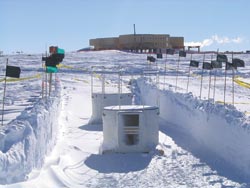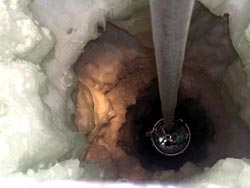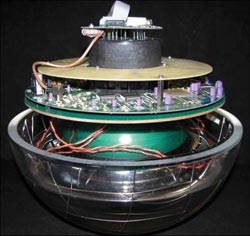Anne L. Fischer, Senior Editor
A telescope under construction at the South Pole will be employed to study the high-energy subatomic particles known as neutrinos. IceCube, as the telescope is called, will consist of up to 4800 basketball-size instruments spread throughout 1 km3 of Antarctic ice, buried 1400 to 2400 m below the surface.
According to Spencer Klein of the Institute for Nuclear and Particle Astrophysics at Lawrence Berkeley National Laboratory in California, a member of the team that designed the digital optical modules used in IceCube, the modules pick out the rare light signal produced by a neutrino colliding with an atom in a water molecule. By collecting data on the intensity and arrival time of the light at multiple modules, the researchers can determine the type, direction and energy of the neutrino that created it. This helps separate a muon generated by a cosmic neutrino from the millions more muons generated by cosmic rays passing through the atmosphere. IceCube will study neutrinos with energies ranging from 200 billion to 1 quadrillion or more electron volts.

Figure 1. Two IceCube tanks are shown in a shallow trench with the new Amundsen-Scott South Pole Station in the background.
Each module includes a Hamamatsu R5912 photomultiplier tube that detects photons, a custom waveform-digitizer chip that converts the photons into readable data and a field-programmable gate array that allows researchers to send and receive information via a twisted-pair cable that connects each module to the surface. The photomultipliers are 10-in. tubes with low dark rates and high quantum efficiency for greater sensitivity. The tubes and associated hardware in the modules detect Cherenkov radiation emitted as the byproducts of neutrino/atom collisions in the ice.
In previous studies, the team used a high-energy neutrino telescope called the Antarctic Muon and Neutrino Detector Array, which has 680 optical sensors. Klein noted that not only are there more sensors on IceCube, but that they have larger photomultiplier tubes and a better data-acquisition system. IceCube’s construction recently began when a cable strung with 60 modules was lowered into a mile-deep hole in the polar ice. The team expects to install the remaining modules over the next five years.

Figure 2. The first of ~80 strings of 60 modules is lowered into a hole in the Antarctic ice. Project construction is expected to take five years.
Besides its 4800 subsurface modules, IceCube includes IceTop, an array of 160 ice-filled tanks on the surface, each containing two modules frozen into it. Eight tanks were installed in December and January.
The detectors in IceTop will be used to calibrate those in IceCube and to study ultrahigh-energy cosmic rays that enter the atmosphere, from the direction opposite IceCube’s orientation, which uses the Earth as a shield.

Figure 3. A digital optical module used in the IceCube project contains a 10-in.-long photomultiplier tube that may one day detect the photon produced when a neutrino strikes an atom in a molecule of water ice.
The aim of the research is to find the sources of ultrahigh-energy cosmic rays. According to Klein, although it is known that there are rays with up to 50 J in a single particle, it is not known where they originate because they are bent by the galaxy’s magnetic field. In contrast, neutrinos travel in a straight line to Earth.
IceCube also will search for hypothesized particles such as magnetic monopoles and Q-balls because, as Klein stated, there are physics models that predict these things but they’ve never been seen.